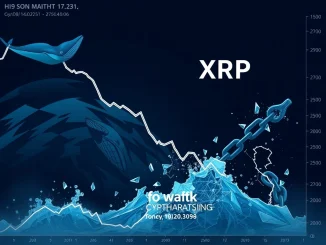
Hold onto your hats, crypto enthusiasts! The market just took a sharp turn south as Bitcoin (BTC), the king of cryptocurrencies, experienced a significant price drop, tumbling below the critical $89,000 mark. This sudden downturn has sent ripples across the entire digital asset landscape, leaving investors wondering: What’s behind this dramatic shift, and more importantly, what’s next? Let’s dive into the details of this developing situation and explore the factors contributing to this market volatility.
Why is Bitcoin Price Plunging? Unpacking the Market Uncertainty
Bitcoin’s recent dip, a noticeable 6% decline to $89,617 (briefly touching $88,355), isn’t happening in isolation. It’s part of a broader wave of market uncertainty sweeping through both traditional and digital asset spheres. Several factors are converging to create this risk-off pressure environment:
- Global Economic Concerns: The announcement by former U.S. President Donald Trump regarding potential tariffs on goods from Canada and Mexico has injected fresh uncertainty into global trade relations. This kind of news often triggers a ‘risk-off’ sentiment, where investors move away from perceived riskier assets like cryptocurrencies and towards safer havens.
- Broader Market Sell-Off: According to insights from Standard Chartered’s Geoffrey Kendrick, Bitcoin’s decline is entangled in a larger sell-off affecting various market segments. This suggests a general bearish sentiment is prevailing, influencing investor behavior across the board.
- Meme Coin Mania Aftermath: Kendrick specifically points to Solana-based meme coins as a contributing factor. The highly volatile nature of meme coins, often driven by hype and speculation, can create instability in the broader crypto ecosystem when their momentum shifts. A pullback in this sector can contribute to overall market bearishness.
In essence, the Bitcoin price drop isn’t solely about Bitcoin itself, but reflects a confluence of external economic factors and internal crypto market dynamics. It’s a reminder that even the most established cryptocurrencies are susceptible to wider market trends and global economic winds.
Crypto Market Under Pressure: Altcoins Bleed as Bitcoin Falls
As Bitcoin falters, the altcoin market is experiencing even more pronounced pain. The domino effect is clearly visible, with significant losses across the board. Let’s take a closer look at how some major altcoins are performing:
| Cryptocurrency | Percentage Drop (Past 24 Hours) |
|---|---|
| Ethereum (ETH) | 10.45% |
| Solana (SOL) | 12.6% |
| Overall Crypto Market | 6.8% |
These figures highlight the amplified volatility often seen in altcoins compared to Bitcoin. When Bitcoin price experiences a downturn, altcoins tend to amplify those movements, both on the upside and the downside. This is due to factors like lower liquidity and higher speculative nature of many altcoins.
Navigating Risk-Off Pressure: What’s Next for Bitcoin?
Amidst this risk-off pressure, what are the potential pathways forward for Bitcoin? While the short-term outlook appears bearish, there are some underlying factors that could offer support in the medium term:
- Lower U.S. Treasury Yields: Interestingly, despite the market downturn, lower U.S. Treasury yields could act as a potential tailwind for Bitcoin in the coming weeks and months. Lower yields make riskier assets like Bitcoin relatively more attractive compared to traditional fixed-income investments.
- Potential Rebound: Despite the current dip, analysts like Geoffrey Kendrick suggest that this could be a temporary setback. He notes that Bitcoin might still decline further, potentially reaching the low $80,000s, before a potential rebound materializes. This suggests that while caution is warranted, long-term bullish sentiment might still prevail.
However, it’s crucial to acknowledge the inherent volatility of the crypto market. Predicting short-term price movements with certainty is incredibly challenging. Traders and investors should approach the current situation with a balanced perspective, considering both potential risks and opportunities.
Inflation Data and the Federal Reserve: Will it Trigger a Market Recovery?
Looking ahead, all eyes are now on the upcoming U.S. inflation data releases. This data will be crucial in shaping expectations regarding the Federal Reserve’s (Fed) next monetary policy move. Why is this so important for the crypto market, and specifically for Bitcoin price?
- Fed’s Influence: The Federal Reserve’s decisions on interest rates have a significant impact on financial markets globally, including the crypto market. Higher interest rates tend to make riskier assets less attractive, while lower rates can have the opposite effect.
- Inflationary Signals: The upcoming inflation data will provide crucial signals about the direction of inflation. If inflation shows signs of easing, it could give the Fed room to become less hawkish (aggressive in raising rates) or even consider easing monetary policy in the future. This could be a positive catalyst for a market recovery, including a potential rebound in Bitcoin and altcoins.
- Market Sentiment Driver: The market’s reaction to the inflation data will heavily influence short-term sentiment. Positive surprises (lower-than-expected inflation) could trigger a relief rally, while negative surprises (higher-than-expected inflation) could exacerbate the current bearish trend.
Therefore, keeping a close watch on the upcoming inflation data and Fed announcements is paramount for anyone navigating the current crypto market uncertainty. These macroeconomic factors will likely play a significant role in determining the near-term trajectory of Bitcoin and the broader digital asset space.
Conclusion: Navigating the Crypto Storm – Stay Informed and Adapt
The recent Bitcoin price drop and the wider crypto market downturn serve as a stark reminder of the inherent volatility and dynamic nature of this asset class. Market uncertainty, driven by global economic factors and internal crypto market dynamics, is currently the prevailing theme. While short-term price fluctuations can be unsettling, it’s crucial to maintain a long-term perspective and focus on staying informed.
Key takeaways for navigating this crypto storm:
- Stay Informed: Keep abreast of macroeconomic developments, particularly inflation data and Federal Reserve announcements, as these factors will heavily influence market sentiment.
- Manage Risk: Understand your risk tolerance and adjust your portfolio accordingly. Diversification and prudent position sizing are crucial risk management strategies.
- Focus on Fundamentals: In times of market volatility, it’s beneficial to revisit the fundamental value propositions of the cryptocurrencies you hold. Focus on projects with strong technology, adoption, and long-term potential.
- Prepare for Volatility: Expect continued price swings in the short term. Volatility is inherent in the crypto market, and periods of downturn are often followed by periods of recovery.
The crypto market is constantly evolving. By staying informed, adapting to changing conditions, and maintaining a long-term perspective, you can navigate these turbulent times and position yourself for potential future opportunities in the exciting world of digital assets.



